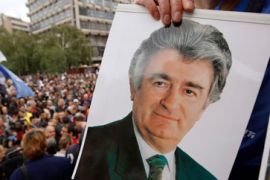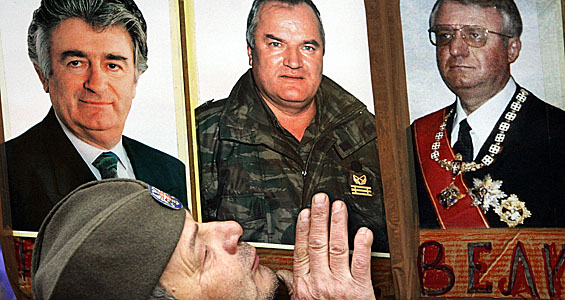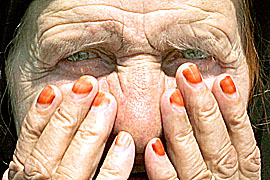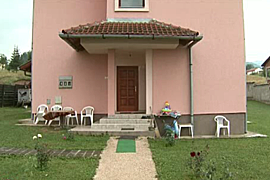Karadzic: Still a Serbian hero?
Al Jazeera reports on the differing attitudes to Radovan Karadzic’s arrest.

 |
| A Serbian kisses photographs of war crimes suspects Karadzic, left, Ratko Mladic, centre, and Vojislav Seselj at a party rally in Belgrade [AFP] |
For more than a decade, the world’s most wanted war crimes fugitive displayed a baffling talent for evading international justice.
Al Jazeera’s correspondent Alan Fisher reports that residents of Bosnia-Herzegovina, the capital of which saw so much bloodshed during the wars in the Balkans, but was also the location of his pink house, have widely varying attitudes to his arrest.
During the wars in the Balkans, Sarajevo, the capital of Bosnia-Herzegovina was an ethnically mixed city. They all lived here – Bosnians, Croats and Serbs, Muslims, Jews and Christians.
But Radovan Karadzic didn’t want that. He saw a Republic that was pure Serb – and so embarked on a campaign been described as “pure evil”. He ordered his Bosnian Serb troops to surround the city, taking up positions in the hills that dominate the skyline.
They tried to strangle the life out of the city. They closed most routes in and out; they stopped food and heating supplies.
But the people were not easily beaten. They used what land there was to grow food, even cultivating the grassy centres of traffic islands.
They used what wood they could find to keep warm during the harsh winters. If the struggle of every day life was not bad enough, for four years they tried to go about normal life in the crosshairs of the Serb snipers and artillery teams.
Thousands of people died.
And that’s why this city which has suffered so much, and which has been waiting so long for justice, celebrated the arrest of the man who tried to wipe them out.
Black humour
Zlatko Lagumdzija, who was deputy prime minister during the Bosnian war in the mid 1990’s, was almost killed in a grenade attack in the city.
 |
| Thousands died under Karadzic’s rule in the Bosnian war in the mid 1990s [EPA] |
He went on to run Bosnia-Herzegovina and now leads the opposition.
After twelve months of treatment for his injuries, the doctor told him he was fixed. “Am I back to normal doctor?” he asked.
“Don’t be ridiculous, you live in Sarajevo,” his doctor said. “You’ll never be normal”.
I meet Mr Lagumdzija near the old national library in town. We discuss the complete transformation of Karadzic – the white hair, the big bushy white beard – which explains perhaps why he was able to hide in plain sight.
We laugh at the black Bosnian humour which jokes that the former psychologist has managed to frame Santa Claus for his crimes.
It would be easy for the former prime minister to be triumphant, but he takes the longer view of a confident politician.
“Karadzic brought his project, which was to kill anyone who wasn’t Serb,” he said.
“The project is dead. Now we must move on a build a Bosnia where everyone is respected. When you have justice where you can settle the past, you can create a better future.”
Pink house
On the streets there is no second night of celebration, but as I drive down the main street I pass the eternal flame lit for the victims of what happened here.
Caught in the silhouette thrown by the fire, I see the figure of a boy no more than eight standing with his father. A child who was not born during the war but will never be allowed to forget what happened here.
The town of Pale is forty minutes drive from Sarajevo, towards the hills. During the war it was a different country.
This was Karadzic’s home, his headquarters, his haven. But now he may never see this place again. At his pink house, number 7 Victor Igo Street, everything is locked and the curtains are drawn, no one answers the knocks on the gate.
People here are reluctant to talk about their most notorious former resident.
 |
| There was no answer at Karadzic’s home in the town of Pale |
Workmen in the next building shout at us and threaten us to leave. I go back to work and so do they.
I ask one of Radovan Karadzic’s neighbours if there is anyone at home. Nervously he tells us the family is rarely seen in public.
“None of the neighbours ever went to visit, and they never visit anyone,” he said.
This house has been under observation by the Nato military alliance for years, hoping something would lead them to Karadzic.
In the house directly opposite of Karadzic’s is where his neighbour, Dragan, lives. Dragan worked with the former psychiatrist before the war and says he was liked and respected. Now, he tells me, it is important justice is done.
“I think everyone should be held responsible for his own acts, to answer for them in the right place and it should be clear to everyone that this is a place where justice and not politics rule,” he said.
Serb hero?
Pale has never trusted outsiders. At the Serb Orthodox church I ask to speak to the priest. He is angry that my crew and I are there and tells us to leave or he will call the police.
He says no one wants to talk about Karadzic and we that just want to enjoy his misery. The final wave of his hand and a slam of the door told us we were dismissed.
At the town hall I speak to the vice president of the municipality who keeps his hands in his pockets when I offer to shake. He is more polite than the priest, but refuses to speak, telling us to go back to Sarajevo.
Pale was Radovan Karadzic’s wartime headquarters. From here he controlled and quite literally executed the policy of ethnic cleansing.
The decisions he made here will be the main plank of the prosecution case against him when he finally appears in the dock at The Hague.
Radovan Karadzic dominated this town for years and does so even now. There are many here who still believe he is a Serb hero – but not many are willing to say it out loud.